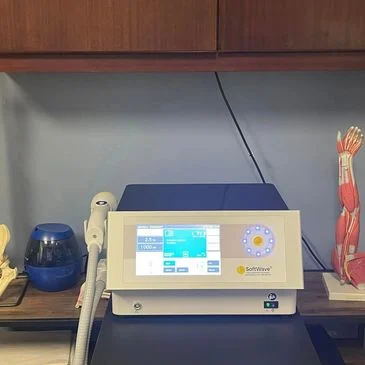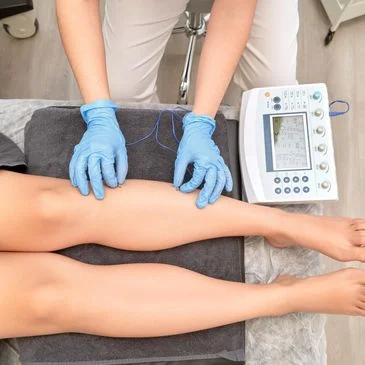Neuropathy Treatments In Whiteland
What is Neuropathy?
Neuropathy is a medical condition that affects the nerves, particularly the peripheral nerves that connect the brain and spinal cord to the rest of the body. It can cause a range of symptoms, including pain, numbness, tingling, and weakness, which can vary in severity depending on the underlying cause and location of the nerve damage.
There are several types of neuropathy, including diabetic neuropathy, which is caused by high blood sugar levels associated with diabetes, and peripheral neuropathy, which can be caused by a variety of factors, such as infections, injuries, toxins, and metabolic disorders
Symptoms of neuropathy can vary depending on the type and severity of the nerve damage, but may include:
Pain or a burning sensation in the affected areas
Tingling or numbness in the fingers and toes
Weakness or loss of coordination, especially in the hands and feet
Difficulty with activities that require fine motor skills, such as buttoning clothes or gripping objects
Loss of reflexes
The treatment for neuropathy depends on the underlying cause and severity of the condition. In some cases, treating the underlying condition may help to alleviate the symptoms. Other treatments may include medications to relieve pain or reduce inflammation, lifestyle changes to manage symptoms, and physical therapy to improve function and range of motion in the affected areas.
SoftWave
SoftWave therapy, also known as ShockWave therapy, is a type of non-invasive treatment that uses high-intensity sound waves to stimulate healing and reduce pain in injured or damaged tissue. While there is limited scientific evidence showing the effectiveness of ShockWave therapy for neuropathy, some studies have suggested that it may be helpful in certain cases.
One study published in the Journal of Neurological Sciences found that low-frequency ShockWave therapy was effective in reducing pain and improving nerve function in patients with peripheral neuropathy. Another study published in the Journal of Diabetes Research found that shockwave therapy was effective in reducing pain and improving sensation in the feet of patients with diabetic neuropathy.
Overall, while ShockWave therapy may be a promising option for treating neuropathy, it should be considered as part of a broader treatment plan that includes lifestyle modifications, medication, and other conservative treatments that have been shown to be effective for this condition.
INDIBA
INDIBA therapy is a non-invasive electrotherapy treatment that uses radiofrequency waves to promote healing and reduce pain and inflammation in damaged tissue. While there is scientific evidence showing the effectiveness of INDIBA therapy specifically for neuropathy, some studies have suggested that it can be helpful in reducing pain and improving function in certain cases.
One study published in the Journal of the American Podiatric Medical Association found that INDIBA therapy was effective in improving nerve function and reducing pain in patients with peripheral neuropathy of the feet. Another study published in the Journal of Physical Therapy Science found that INDIBA therapy was effective in reducing pain and improving function in patients with carpal tunnel syndrome, which is a type of neuropathy that affects the hand.
However, as with any medical treatment, it is important to work with a licensed healthcare professional who is experienced in this type of treatment and can discuss its potential benefits and risks with you. INDIBA therapy may not be appropriate for everyone and should be considered as part of a broader treatment plan that includes other conservative treatments such as lifestyle modifications, medication, and physical therapy.
Perineural Stimulation
Perineural stimulation is a form of electrotherapy that involves the use of implanted electrical leads to stimulate the peripheral nerves that are affected by neuropathy. It has been used to treat various types of neuropathy, including diabetic neuropathy and peripheral neuropathy.
Perineural stimulation works by generating small pulses of electricity that are delivered directly to the affected nerves. This electrical stimulation can help to reduce pain, improve nerve function, and promote the regeneration of damaged tissue.
While perineural stimulation is still considered an emerging treatment option for neuropathy, there is evidence to suggest that it can be effective in reducing pain and improving nerve function.
For example, a study published in the Journal of Neurosurgery found that perineural stimulation was effective in reducing pain and improving sensation in patients with chronic peripheral neuropathy.
If you are considering perineural stimulation for neuropathy, it is important to work with a licensed healthcare professional who is experienced in this type of procedure and can discuss its potential benefits and risks with you.
Infrared Red Light Therapy
Infrared light therapy (IR) is a healing modality that uses infrared light to treat various conditions. Neuropathy is a condition that affects the nerves and can cause pain, numbness, and weakness in the extremities, such as the hands and feet. Can IR therapy help in treating neuropathy?
There is some evidence to support the use of IR therapy in managing neuropathy symptoms. Infrared light is known to improve circulation, increase the production of nitric oxide (a molecule that helps to relax blood vessels), and reduce inflammation. These effects can help to relieve pain and numbness associated with neuropathy.
Studies have suggested that IR therapy can be effective in treating diabetic neuropathy, which is a type of nerve damage that can occur in people with diabetes. In one study, patients with diabetic neuropathy who received IR therapy showed significant improvements in their symptoms compared to those who received a placebo treatment.
Exercise
Exercise can be an effective way to manage neuropathy symptoms. Regular physical activity has been shown to improve circulation, reduce inflammation, and promote the growth of new blood vessels and nerves. These effects can help to reduce pain and improve mobility in individuals with neuropathy.
However, it is important to choose the right type of exercise and consult with a healthcare provider before starting an exercise program. Some types of exercise may not be appropriate for individuals with certain medical conditions or may need to be modified to accommodate neuropathy-related limitations.
Low-impact exercises such as walking, cycling, and swimming can be good options for individuals with neuropathy since they put less stress on the joints and nerves. Strength training exercises can also be helpful for maintaining muscle mass and reducing the risk of falls.
Additionally, stretching and balance exercises can also be incorporated into an exercise program to help improve flexibility and reduce the risk of falls. Yoga and tai chi have also been found to be beneficial for individuals with neuropathy due to their focus on balance, flexibility, and gentle movements.
Overall, regular exercise can be an important part of managing neuropathy symptoms. However, it is important to work with a healthcare provider to develop a safe and effective exercise plan that addresses the individual’s specific needs and limitations.








